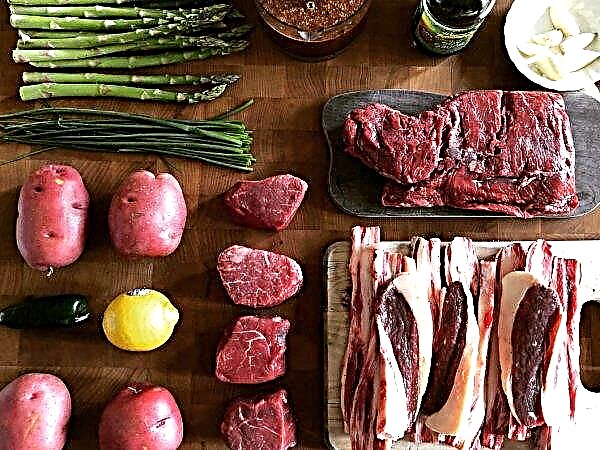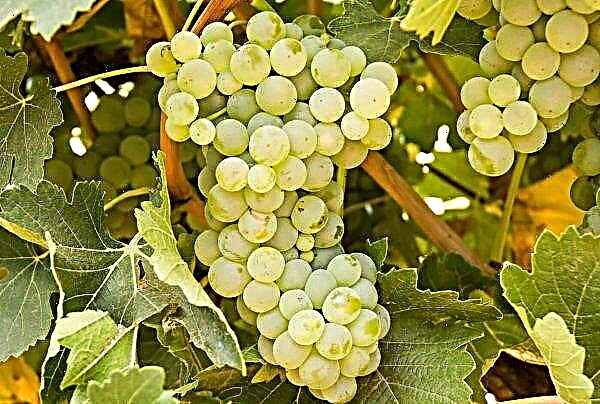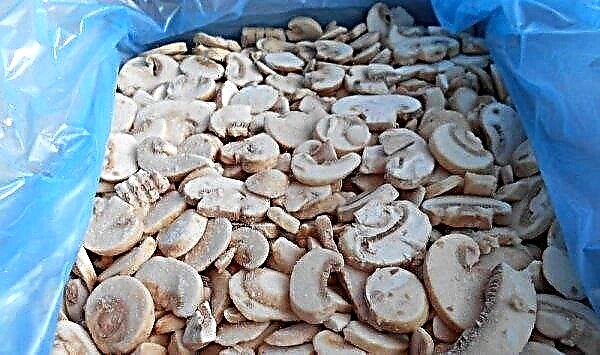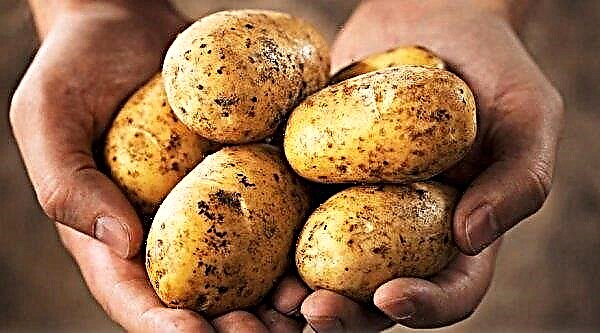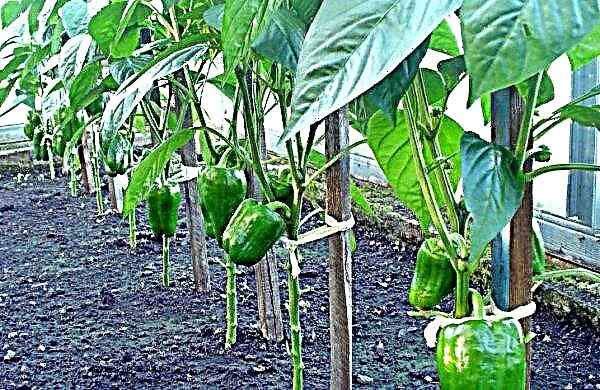Vegetable hybrids have always been characterized by higher rates and it is not in vain that they are in demand among gardeners. The Dutch eggplant variety Valentine was no exception. Consider what a hybrid of Valentine is, its characteristics, how to grow and care, collect and store.
Grade description
This is an early ripe high-yielding hybrid, which is characterized by unpretentiousness and resistance to many diseases. In addition, the fruits have high palatability, do not accumulate a lot of solanine, which means they are not bitter and are suitable even for raw consumption.
Did you know? Eggplants were first cultivated in the territories of Central and South Asia, India in about the VI century. It is there that its wild species grow now.
Eggplant Story Valentine
Hybrid eggplant Valentine F1 was obtained by Monsanto (Netherlands). In 2007, he was included in the State Register of the Russian Federation. It is recommended for cultivation in protected ground throughout the territory of the Russian Federation, has shown excellent results in open beds in the southern regions, Moldova and Ukraine.
Characteristic
The first fruits are received on the 90th day from the appearance of seedlings. The yield from each m² of beds is 3.2 kg. And in sheltered ground, this figure is even higher due to a longer fruiting period.
It forms a semi-spreading bush of medium or high size 85–90 cm high with strong roots. The stem is not thick, with a weak edge and short internodes. Rough leaves of usual medium size, green color with weak undulation and noticeable veins. Blooms with purple flowers.
They are tied with pear-shaped fruits with a dark violet glossy surface and a thin strong skin on a long stalk. They have a dense pulp of a light color and without bitterness. Everything else, it is almost seedless, tender and soft.
It can be used in diet food, has universal use. Fruits weigh on average 200–220 g and grow about 26 cm long and 5 cm in diameter.
The variety bears fruit even in cool and rainy weather, it has excellent resistance to tobacco mosaic and many other diseases characteristic of this culture.
Did you know? The blue ones contain chlorogenic acid, which is very useful for the cardiovascular system, which has oncoprotective, antidiabetic and anti-tuberculosis effects.
Cultivating varieties
Hybrid Valentine is grown in seedlings, like all eggplants in Russia. Seeds are planted in early March from the calculations that seedlings will need to be planted in a permanent place at the age of 45–55 days from the appearance of seedlings. The soil on the beds at this time should warm up to + 18ºC. Dutch seeds do not need to be pickled in potassium permanganate before sowing, but they can be soaked in a simulator (Epin, Zircon). Then they can be sprouted to check germination and get friendly shoots, or you can plant them right away in prepared containers with soil mix.
Dutch seeds do not need to be pickled in potassium permanganate before sowing, but they can be soaked in a simulator (Epin, Zircon). Then they can be sprouted to check germination and get friendly shoots, or you can plant them right away in prepared containers with soil mix.
In the first case, before landing, they are placed for a couple of days in a moistened cloth or napkin and kept at a temperature of + 25 ... + 26 ° С.
The root system of eggplant does not tolerate unnecessary transplants, so it is better to plant seeds in separate containers. Soil is easiest to buy ready-made in the store. If desired, you can make the nutrient mixture for planting of 2 parts of humus, 1 part of turf (peat) and 1 part of sand.
Homemade soil must be decontaminated by baking in the oven. Then it is recommended to add fertilizers to it - 40 g of nitrophoska and a glass of ash in a 10-liter bucket of the mixture.
1-2 seeds are planted in each planting site in moderately moistened soil to a depth of 1-1.5 cm, covered with a film and placed in a warm dark place (+ 25 ... + 28 ° С). The soil is kept moist and after 10-15 days seedlings appear. Seedlings are transferred to a lit place a slightly less warm place with lowering night temperatures to +17 ... + 18 ° С.
Further, seedlings are periodically watered with settled water. Sometimes Fundazole is added to it during watering for preventive purposes and fed.
Top dressing is done twice:
- In the stage of 2-3 sheets. Pour a solution of 5 g of urea and 30 g of superphosphate in a 10-liter bucket.
- 7 days before landing. It is best to use complex fertilizer "Kemira".
 2 weeks before planting, it is recommended to harden the seedlings - begin to take them to the balcony. First, just a couple of hours, then the time spent in the fresh air is increased. On the eve of the landing, the eggplants should already spend the night on the balcony.
2 weeks before planting, it is recommended to harden the seedlings - begin to take them to the balcony. First, just a couple of hours, then the time spent in the fresh air is increased. On the eve of the landing, the eggplants should already spend the night on the balcony.The garden bed is best prepared in the fall and add organic matter (manure, humus) when digging for the winter. If this was not done, then in the spring you can make rotted manure. Eggplants love nutritious light soils.
If the soils are heavy, then sand or sawdust is introduced into them. Before planting, it is possible to introduce complex mineral fertilizers into the soil (Kemira station wagon). The beds should be well lit.
Important! Eggplants do not plant on beds where solanaceous crops (eggplant, tomatoes, peppers, potatoes) grew earlier.
Plants are planted in holes at a distance of 30 cm from each other and between rows of 0.6 m.
Eggplant Care
After planting the eggplant in the beds, it is necessary to ensure proper care for them.
Proper watering
Heat-loving eggplants are watered with settled warmed water under the root. The first watering is done only 5 days after planting seedlings. Then it is watered once a week, but when the fruits appear, it will be necessary to water it already twice a week.
Top dressing
Fertilize Valentine eggplant must be at least 2 times:
- 2 weeks after transplanting, it is recommended to feed with complex fertilizers (Kemira or Mortar).
- When the fruits began to be tied. Feed a solution of 25 g of superphosphate and 25 g of potassium salt in a 10-liter container.
Temperature mode
Eggplant loves warmth. You need to plant in open ground only when the soil warms up to + 15 ° C, and the air temperature is + 18 ° C.
These vegetables do not tolerate low air temperatures. A decrease below + 10 ° C is fatal for the plant. The optimum temperature for vegetation is considered to be +28 ... + 30 ° С.
Pest and disease protection
Variety Valentine is resistant to viral diseases, but when grown, you should beware of fungal diseases.
To prevent their occurrence, you must adhere to the following rules:
- observe crop rotation;
- ventilate the greenhouse 1-2 times a day;
- to carry out preventive spraying with chemical preparations like “Fitosporin”, “Zircon”.
 Often affected by such fungal diseases as gray rot, late blight. Against phytophthora, treatment with the chemical agent “Quadris” helps well, and against gray rot with “Horus”.
Often affected by such fungal diseases as gray rot, late blight. Against phytophthora, treatment with the chemical agent “Quadris” helps well, and against gray rot with “Horus”.This plant crop is most susceptible to invasion by pests such as slugs, spider mites and aphids. To combat them, the chemical product Strela gives a good result. For the prevention of aphids and fungal diseases, it is necessary to conduct treatment with a solution of wood ash.
Another misfortune is the Colorado beetles. These pests and their larvae can be collected manually, or sprayings can be applied with the chemical Konifor.
To scare away insect pests, you can plant marigolds, marigold, basil between the beds.
Harvesting and Harvesting
Once the eggplants have a characteristic dark purple color and grow to a length of about 21–25 cm, you can start harvesting. The main thing is not to miss the moment of their technical maturity, as overripe vegetables will have bitterness and large rough seeds.
To determine the technical maturity, just press the finger with a finger. A dent should form on it, which disappears almost immediately. Fruits can be stored in a cool room for about a month and perfectly tolerate transportation. They can be used for cooking any dishes and even eat raw. They make excellent workpieces.
Fruits can be stored in a cool room for about a month and perfectly tolerate transportation. They can be used for cooking any dishes and even eat raw. They make excellent workpieces.
Important! Overripe specimens must be collected and not left on the bush, so as not to delay the formation of new fruits.
Eggplant varieties Valentine are early ripe and have excellent taste. Since this hybrid gives high yields and is resistant to various adverse factors, it is an excellent choice for gardeners.

